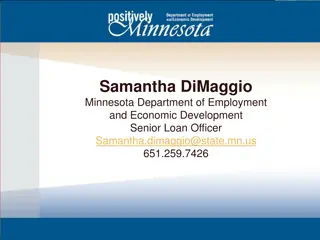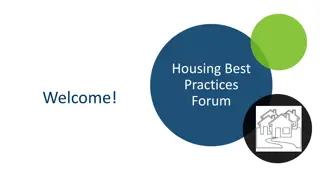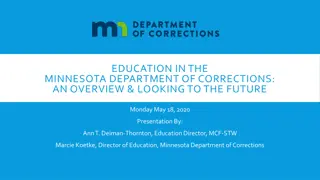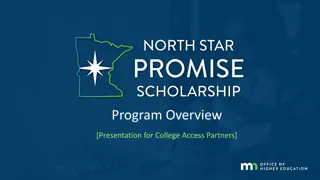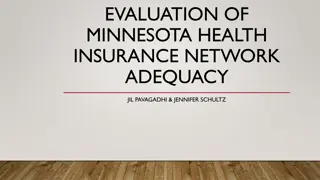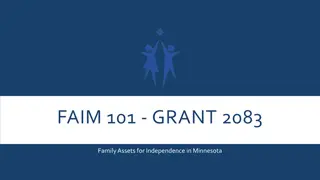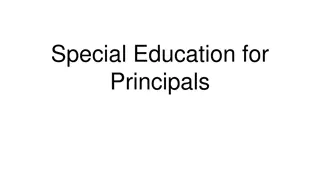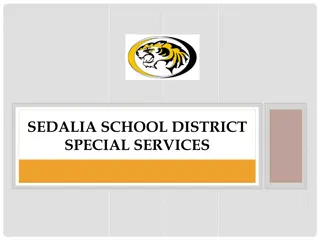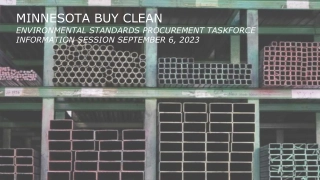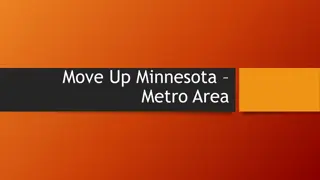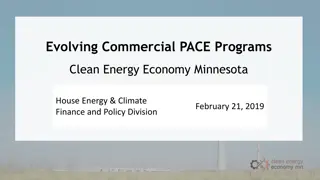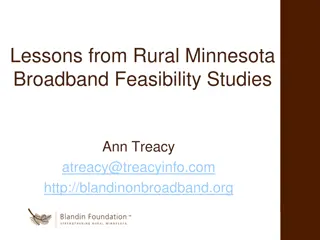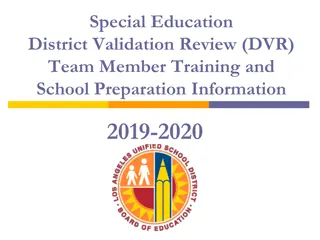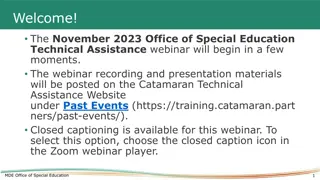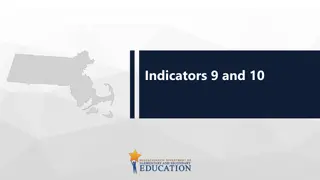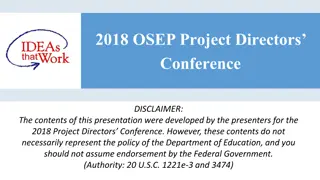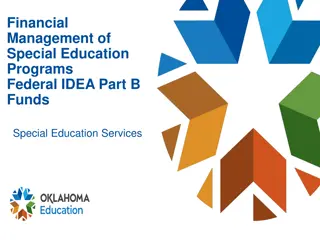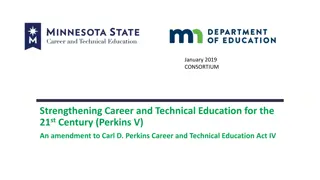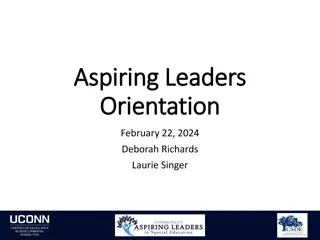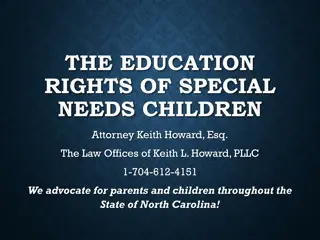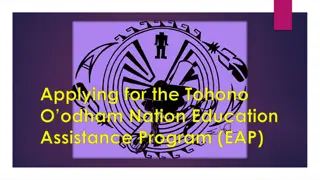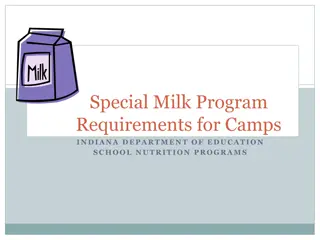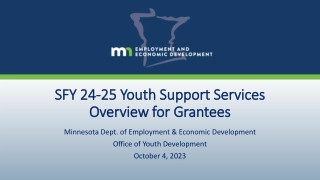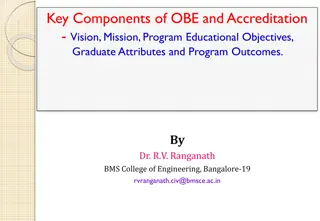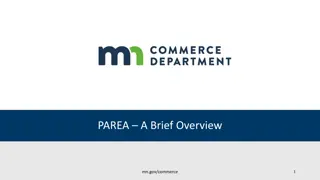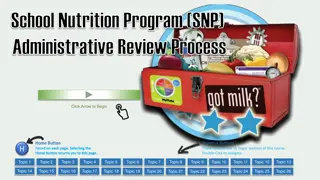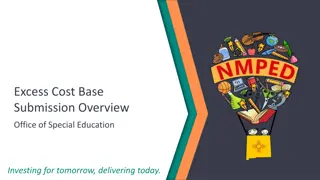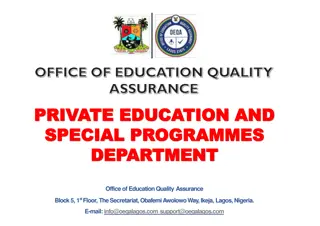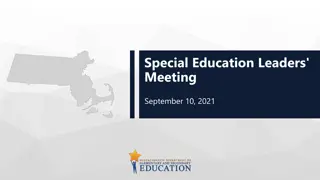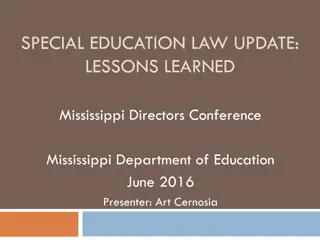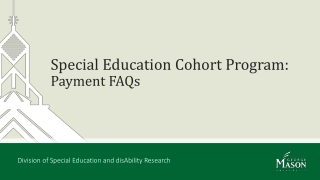Special Education Program Process in Minnesota
Explore the identification and Individualized Education Program (IEP) process in Minnesota for students with special needs. Learn about the basics, timelines, initial evaluation, ongoing process, and a tale of two students' strengths and areas of need. Discover how the IEP team develops and implements educational plans to support students' academic progress and success.
Download Presentation

Please find below an Image/Link to download the presentation.
The content on the website is provided AS IS for your information and personal use only. It may not be sold, licensed, or shared on other websites without obtaining consent from the author. Download presentation by click this link. If you encounter any issues during the download, it is possible that the publisher has removed the file from their server.
E N D
Presentation Transcript
Special Education in Minnesota: Identification and Individualized Education Program (IEP) Process Minnesota House of Representatives Education Policy Committee Minnesota Administrators for Special Education (MASE) Jamie Nord & Nicole Woodward St. Croix River Education District
Introduction to the Basics and the Timelines: Handouts Identification and IEP Process: A Tale of Two Students People, Paperwork, Process Challenges and Potential Solutions Presentation Overview
Identification & IEP Process: The Basics ...
Ongoing Special Education Process Comprehensive Reevaluation 7 7 At least every three years, a student must be re-evaluated to determine if the student demonstrates a continuing need for special education services. This information should inform the development of the IEP. IEP Development Once the initial evaluation is complete the team will meet to review the results. If the student qualifies for special education services , an Individualized Education Plan (IEP) will be developed for the student. If the student currently has an IEP, existing data and/or the results of the student re- evaluation will be used to develop a revised IEP Implementation 6 6 5 5 The school team will implement the services specified in the student s IEP. This includes monitoring the student s progress on their IEP goals. If adequate progress is not being made, the team should consider making an instructional change. Note: Parental consent is required before implementation of an initial IEP. IEP.
Identification & IEP Process: The Timelines ...
Identification & IEP Process: A Tale of Two Students ...
The Students Sunnie Stella Grade: 6 Class size: 34 Strengths: skilled in the arts and is a robotics whiz , has strong friendships and a great sense of humor. Areas of Need: reading fluency and reading comprehension, academic engagement, disruptiveness in the classroom Grade: 6 Class size: 28 Strengths: excels in physical education and plays multiple sports; demonstrates a passion for nature and the environment Areas of Need: reading fluency and reading comprehension, academic engagement, disruptiveness in the classroom
Step 1: Pre-referral Intervention Sunnie Stella Due to budget reductions, the intervention program has been eliminated at Sunnie s school Sunnie s classroom teacher, in collaboration with the school psychologist, attempts to implement several strategies that facilitate improvement in Sunnie s behavior and reading performance Sunnie continues to struggle and disengages from academic instruction Sunnie s teacher shares her concerns about Sunnie s behavior and reading with her parents at conferences The 6th grade team reviews grade-level data and identifies Stella as a student who is at-risk in the areas of reading and behavior Stella is placed in a supplemental, small group evidence-based reading interventions and Check & Connect, an evidence-based behavior intervention Stella begins making significant progress in her reading skills, which has a positive effect on her behavior and academic engagement Stella s teacher reviews her progress with her parents at conferences
Step 2: Referral Sunnie Stella Growing increasingly concerned with their child s reading and behavior difficulties, Sunnie s parents reach out to the school to request a special education evaluation. Sunnie s parents put their request in writing (requirement) In response, the school team holds an initial evaluation planning meeting At the meeting, the team discusses with parents other intervention options to consider prior to evaluating. Because of their concerns, Sunnie s parents persist with their request and the pre-referral requirement is waived. Stella s parents are pleased with her progress and set up time to check back in with her teacher at spring conferences Due to her progress, the team discontinues Stella s Check & Connect intervention and continue to work on improving her reading skills Stella s parents do not request a special education evaluation
Step 3: Consent Paperwork Process People Parents Case Manager Evaluation Plan Prior Written Notice Parental Consent/Objection Form Team responds to request in a reasonable amount of time Paperwork gets sent home to parents for consideration Parents provide consent in writing Evaluation begins Vestibulum congue tempus Evaluation Team: School Psychologist EBD Licensed Teacher SLD Licensed Teacher School Nurse Lorem ipsum dolor sit amet, consectetur adipiscing elit, sed do eiusmod tempor.
Sunnies parents provide consent in writing to the initial evaluation.
Step 4: Initial Evaluation Paperwork Process People Parents Case Manager Assessment Tools/Protocols Evaluation Report Present levels Information from Parents Summary of all Results Variety of sources Determination of eligibility Educational Needs Team has 30 school days to complete evaluation Assessment tools administered Observations and interviews completed Need for assistive technology addressed Review of records Results must be synthesized/analyzed Team meeting* to review results Vestibulum congue tempus Evaluation Team: School Psychologist EBD Licensed Teacher SLD Licensed Teacher School Nurse General Education Teacher(s) Lorem ipsum dolor sit amet, consectetur adipiscing elit, sed do eiusmod tempor. *no legal requirement to meet
Based on the evaluation results, the team determines Sunnie meets initial eligibility requirements for a Specific Learning Disability (SLD).
Step 4: IEP Development Paperwork Process People Parents SLD licensed Special Notice of Team Meeting Draft IEP Prior Written Notice Parental Consent/Objection Form IEP Team, consisting of all required members, meets to develop initial IEP within 30 calendar days of eligibility determination IEP is sent home within a reasonable timeframe for parents to review and consider Team waits for consent Vestibulum congue tempus Education Teacher General Education Teacher(s) Qualified district representative/Administrator Behavior skills service provider Lorem ipsum dolor sit amet, consectetur adipiscing elit, sed do eiusmod tempor.
The IEP includes: Present levels of academic achievement and functional performance (PLAAFP), goals, objectives and services in the areas of reading and behavior, as well as accommodations and modifications to be implemented in the general education setting, including the consideration of assistive technology. Paraprofessional support is included in the plan. Sunnie s parents provide consent to the initial IEP proposed by the District.
Step 4: IEP Implementation Paperwork Process People Case Manager Special Education Service IEP Progress Monitoring Activities Data collection Progress Report ESY Determination Amendment Agreement to Amend Prior Written Notice Amended IEP Case Manager communicates to team that consent is received and services can begin General Education Teacher implements accommodations and modifications Special education services provided as prescribed Progress is monitored Data-based decision making Progress periodically reported to parents Vestibulum congue tempus Providers General Education Teacher(s) Paraprofessional Lorem ipsum dolor sit amet, consectetur adipiscing elit, sed do eiusmod tempor.
Step 4: Comprehensive Re-evaluation Paperwork Process People Prior Written Notice Evaluation Plan Parental Consent/Objection Assessment Tools/Protocols IEP Evaluation Report Present levels Assessment Results Summary Determination of continued need/continued disability Educational Needs Additions and Modifications* Parents Case Manager Team re-evaluates every three years, at minimum Once consent is received team must complete re- evaluation in 30 school days Team meets to review IEP and make revisions based on evaluation results IEP development process resumes Vestibulum congue tempus Evaluation Team: School Psychologist EBD Licensed Teacher SLD Licensed Teacher School Nurse General Education Teacher(s) Lorem ipsum dolor sit amet, consectetur adipiscing elit, sed do eiusmod tempor.
Re-evaluation Report Additions and Modifications
Re-evaluation: Additions and Modifications Previously Re-evaluation report needed to identify educational needs, included accommodations and modifications in the classroom and any needed assistive technology Now Re-evaluation report needs to identify educational needs, included accommodations and modifications in the classroom and any needed assistive technology. In addition, progress toward IEP goals needs to be reviewed and the re-evaluation report must include one of the following: If the student is making adequate progress, the re-evaluation report must state that progress is sufficient and no additions and modifications to the special education program (different from accommodations and modifications are needed. If the student is not making adequate progress, the re-evaluation report must state that progress is insufficient and then list out the specific additions or modifications the team will make to the special education program.
Annual IEP Prior Written Notice (PWN)
Description of the action(s) proposed or refused by the district on Prior Written Notice Previously The District proposes an annual IEP. Then changed to The District proposes an annual IEP as was discussed with you at the IEP Team meeting held on September 15, 2018. Now The district is proposing to provide continued direct instruction in reading to address Sunnie s Specific Learning Disability. She will continue to receive services in the resource room, as well as accommodations and modifications in the classroom including shortened assignments, the option of having tests read to her in a quiet setting, and paraprofessional support. Please see attached IEP dated September 15, 2018.
Challenges Potential Solutions Special Education as the only solution Support the implementation of a Multi- Tiered System of Supports (MTSS) Special Education paperwork requirements Limit MDE interpretation of requirements Support meaningful paperwork reduction legislation Accountability focus is on paperwork, not results Accountability focus shifts to results
Jamie Nord, Executive Director St. Croix River Education District jnord@scred.k12.mn.us 651-303-6352 Questions? John Klaber, Executive Director jpklaber@gmail.com 507-469-9096 Nicole Woodward, Director of Special Education St. Croix River Education District nwoodward@scred.k12.mn.us 651-600-8011
Additional Information: Challenges & Solutions ...
Challenge: Special Education as the Only Solution When schools lack a comprehensive intervention structure to address academic and behavior needs at all prevention levels, a higher number of students are referred for special education services. This results in increased special education staffing and resource allocation. Current available financial resources to support pre-referral intervention structures are limited, and those available do not provide the flexibility we need to meet student instructional needs in an efficient way (i.e., Alternative Delivery of Specialized Instructional Services-ADSIS).
Challenge: Special Education as the Only Solution Research supports students with disabilities having access to core instruction plus supplemental, targeted instruction in order to close the achievement gap. Districts lack resources to support inclusive practices, such as co-teaching, to maximize benefit of content specialist (Gen Ed Teacher) and strategies specialist (Special Ed Teacher).
Solution: Support the Implementation of a Multi- Tiered System of Supports (MTSS) Minnesota Administrators for Special Education (MASE) supports: the integration of a district-wide, unified Multi-Tiered System of Supports (MTSS) to meet the academic and social emotional needs of all learners and reduce the achievement gap. the implementation of a MTSS framework, that uses evidence-based strategies in the areas of academic and behavioral supports, including school climate and social emotional learning in collaboration with county social services, county public health, and other groups supporting the mental health needs of children and youth. the review of special education eligibility criteria to align with research and needs-based MTSS framework.
Solution: Support the Implementation of a Multi- Tiered System of Supports (MTSS) Minnesota Administrators for Special Education (MASE) supports: the dedication of state funding in districts to provide professional development opportunities, technical assistance, and instructional coaches, peer supports, and training for implementation of the MTSS framework ages birth through 21. the dedication of state funding in districts to develop continuums of services that meet the needs of districts of all sizes in literacy, math, and behavior. funding that is driven by student needs and does not place students into siloed programs. In other words, the restrictions surrounding instructional funding need to be lifted to allow for programming based off student need, not funding source.
Challenge: Special Education Paperwork Requirements MDE interpretation requires more than what is required by state or federal law Driven by what district must have documented when monitored or responding to a complaint or due process hearing No significant changes to Federal or State laws, yet due process standards that MDE holds districts accountable for have been steadily increasing
Solution: Limit MDE Interpretation of Requirements Limit MDE s interpretations to those that enhance programming for students and minimally do not negatively impact the provision of services
Challenge: Accountability Focus is on Paperwork Not Results In order to meet the paperwork demands, Special educators: use their prep time to complete paperwork, instead of planning for high quality, effective instruction receive professional learning focused on due process paperwork, instead of on high- leverage instructional practices Special education administrators: have little to no time to focus on improving programming for special education students become due process experts, instead of instructional leaders
Solution: Accountability Focus Shifts to Results Legislatively direct MDE s Compliance and Assistance Department to develop a monitoring process based on results Emphasize student response to specially designed instruction Hold districts accountable for student progress on individual IEP goals MDE Technical Assistance needs to focus on: Data-Based Decision Making High-Leverage Practices in Special Education Specially Designed Instruction
It is what is best for kids! Puts focus back on instruction, not on paperwork Help to close SPED achievement gap Increase efficiency and effectiveness In some cases, prevent students from needing special education services Less time spent on paperwork requirements, more time spent providing high quality instruction to students Teacher Shortage Recruit more teachers without all the burdensome paperwork requirements Keep special education teachers from leaving the field by reducing paperwork Reduce Special Education Expenditures In some cases, prevent students from needing special education services Improve the quality of instruction provided to special education students, thus resulting in improved outcomes



